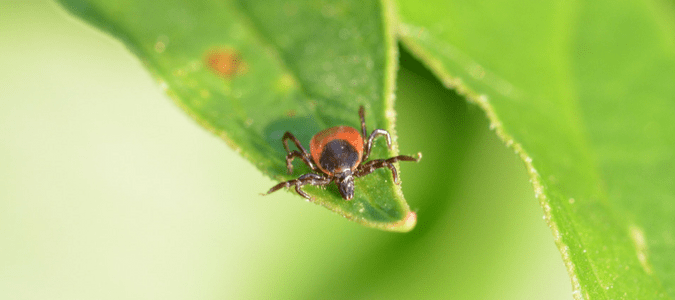
There are many reasons we love living in Texas. The unfortunate reality, however, is that we share this great state with a small, but potentially dangerous pest: ticks. What types of ticks live in Texas? Where do they live? How can you prevent tick bites? Perhaps most importantly, how do you get rid of ticks? Read on to learn everything you need to know about Texas ticks.
Everything You Need to Know About Texas Ticks
The four most common types of ticks found in Texas, in order of frequency, are the:
- Brown dog tick (Rhipicephalus sanguineous)
- American dog tick (Dermacentor veriabilis)
- Lone star tick, also known as the northeastern water tick or turkey tick (Amblyomma americanum)
- Deer tick (Ixodes scapularis)
All four types of ticks are hard-shelled, meaning they have a hard covering over their body. Interestingly, the shell covers more of the body in the male tick than the female.
Ticks go through four stages during their lifetimes: egg, six-legged larvae, eight-legged nymph and adult. Ticks attach themselves to a warm-blooded host and feed until they’re engorged at each stage. Depending on the availability of food sources, it can take up to three years for a tick to go from egg to adult, with most ticks dying before reaching maturity.
Ticks cannot fly or jump, so they find their hosts by hanging onto blades of grass or leaves, usually along a well-worn path. As the host passes by, the tick grabs hold with its free legs and quickly passes from the leaf or blade onto the host. Ticks will then find a nice place to insert their sucker and dine until they’re full. Once full, they’ll drop off, molt into the next stage of life and the cycle begins again.
Ticks As a Disease Vector
Ticks are carriers of several blood-borne diseases, the most serious of which is Lyme disease. According to the Texas Lyme Disease Association (TLDA), since 2000, “the number of reported cases in Texas has ranged between 50 and 100, with probable cases (those which do not meet the strict CDC reporting criteria) at twice that number.” The TXLDA reports that it typically receives between 600 and 900 requests a year from Texans looking for medical care for Lyme disease symptoms.
Lyme disease is often misdiagnosed in Texas, according to the TXLDA, since many physicians believing there are few ticks in Texas and that Lyme disease does not exist. Classic symptoms of Lyme disease start with a flu-like feeling, followed by a rash that starts at the site of the tick bite. Without treatment, the disease continues to overtake the patient, with arthritis in the joints, severe headaches, facial droop and nerve pain. The impact of Lyme disease can be quite serious, leaving the affected person unable to work or carry out many regular activities.
In total, there are six tick-borne illnesses in Texas, each with similar symptoms but caused by different strains. The two most common are Lyme disease and Rocky Mountain Spotted Fever.
Controlling Ticks
Do fire ants control the number of ticks in Texas? This urban legend is a myth. While ants, spiders and birds eat ticks, ticks are not these animals’ main source of food, so they are relatively ineffective to control the tick population in your yard.
One pesticide, acaricides, can be effective in reducing the number of ticks in your yard, but it will, by no means, give you total control. It is also something that needs to be applied by a licensed, experienced pest control specialist, as the pesticide can be toxic to humans and pets.
The best way to control ticks is by creating a tick-free perimeter around your home. If you are wondering how to control ticks in your yard, consider taking the following measures:
- Keep grass mowed short on a regular basis.
- Properly dispose of piles of leaves, trimmings, and trash.
- Remove piles of wood from around the house and walkways.
- Put a three-foot barrier of wood chips and/or rocks or other landscaping material, around the foundation of the house and patio, separating the recreational areas from areas where ticks thrive.
- Keep children’s play areas away from fences, trees and the edges of the lawn.
How To Remove A Tick
What if you, your child or your pet finds a tick on them? There are many old wives’ tales about getting rid of ticks, such as burning them, or coating them with petroleum jelly or nail polish. There are obvious risks associated with trying to burn something so close to your skin, which can cause even more problems.
According to the CDC, the do don’ts of tick removal include:
- Using tweezers and rubber gloves, grab hold of the tick as close to the skin as you can get.
- Apply steady pressure and pull it out.
- DO NOT twist or jerk the tick; the head or mouth may be left behind.
- DO NOT crush the tick; the fluids can be infectious.
- Dispose of the removed tick immediately by flushing it down the toilet.
- After removal, thoroughly disinfect the area and wash hands with warm water and soap.
Trust ABC To Get Rid of Ticks
Are there ticks in Texas? Absolutely. And they’re out for blood–literally. Take care of your lawn using the common-sense techniques above and you’ll be better able to control ticks in your yard. And remember: our specialists at ABC Home & Commercial Services are experts at keeping your home and yard safe from pests of all types. If you have a problem with any kidn of lawn pest, call on us to get the job done.
